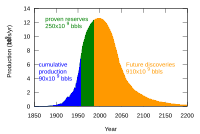
Photo from wikipedia
This paper presents the application of prediction in the analysis of market price volatility in Polish conditions of wood processing by-products in the form of biomass. The ARIMA model, which… Click to show full abstract
This paper presents the application of prediction in the analysis of market price volatility in Polish conditions of wood processing by-products in the form of biomass. The ARIMA model, which takes into account cyclical, seasonal, irregular fluctuations of historical data on the basis of which the forecast and long-term trends of selected wood products were made, was used in predicting prices. Comparisons were made between the ARIMA prediction method and the multiplicative Winters–Holt model. During the period studied (2017–2022), the changes in the market price of biomass were characterized by a wide spread of values. On average, the price of these products increased from 2017 to the end of 2022 by 125%. The price prediction analysis showed seasonal fluctuations in the case of wood chips. The uncertainty in price prediction is due to changes in supply resulting from the influence of global factors. The Diebold–Mariano test of matching accuracy confirms that the price prediction of the analyzed by-product sorts using the ARIMA and WH models is possible. The conclusion reached by comparing these two methods is that each can be used under certain market conditions of certain assortments. In the case of a stable wood product, the choice of the ARIMA model should be resolved, while in the case of price volatile products, WH will be a better choice. The difference between the predicted and actual price with ARIMA ranged from 2.4% to 11.6% and for WH from 3.7% to 29.8%.
Journal Title: Energies
Year Published: 2023
Link to full text (if available)
Share on Social Media: Sign Up to like & get
recommendations!